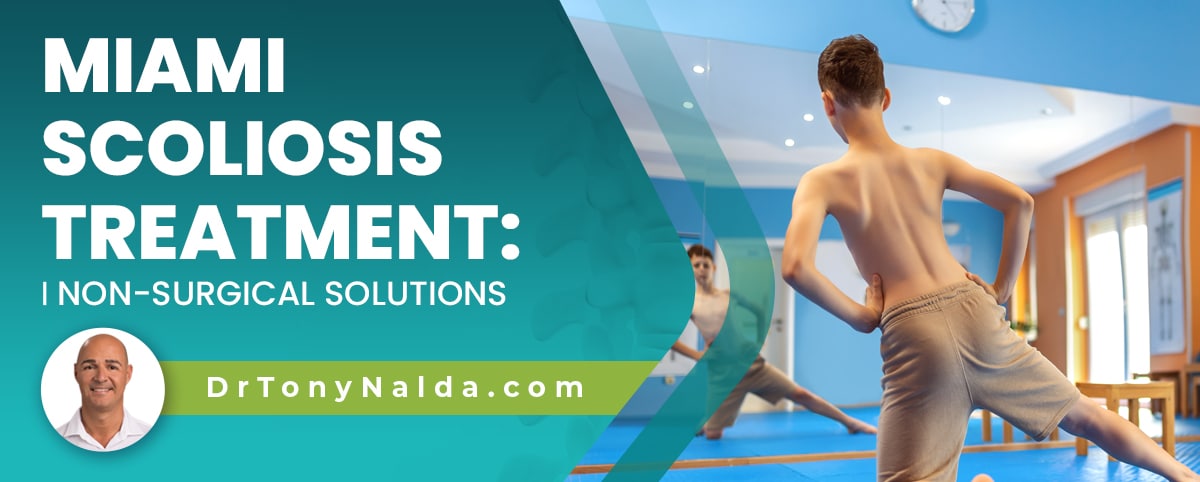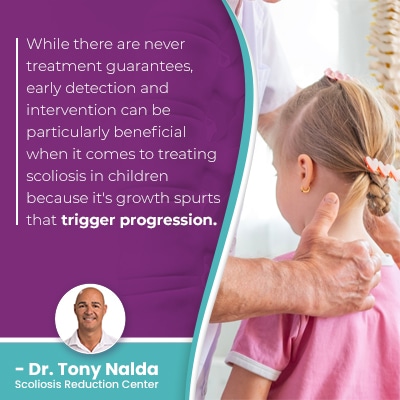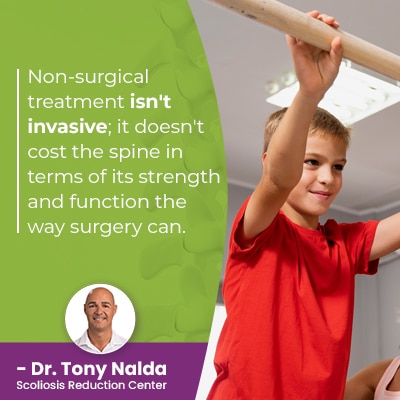Miami Scoliosis Treatment: Non-Surgical Solutions

The typical path of scoliosis treatment doesn't always include non-surgical solutions, yet spinal surgery can be risky, costly, and invasive. The most important decision scoliosis patients have is how to treat their condition because this will shape the spine's overall health.
A 3.5-hour drive from Miami to Orlando means Miami scoliosis treatment can include Dr. Tony Nalda's Scoliosis Reduction Center®, where results speak for themselves. Non-surgical treatment solutions for scoliosis can help preserve the spine's long-term health and function.
Let's follow a typical course of treatment for an adolescent recently diagnosed, and talk about the importance of treatment-option awareness.
Table of Contents
Diagnosing Adolescent Idiopathic Scoliosis
There are different severity levels of scoliosis that include mild scoliosis, moderate scoliosis, severe and very severe scoliosis, and this is based on the size of the unnatural sideways-bending spinal curve and the level of rotation.
There are also different types of scoliosis, and type is determined by a condition's underlying cause; in approximately 80 percent of diagnosed cases, the cause is idiopathic, meaning not clearly associated with a single-known cause.
The remaining 20 percent are associated with known causes and are considered atypical: neuromuscular scoliosis, degenerative scoliosis, and congenital scoliosis.
Adolescent idiopathic scoliosis is the most prevalent type overall, and it's diagnosed in adolescents between the ages of 10 and 18; part of diagnosing scoliosis involves further classifying cases based on key characteristics such as patient age, condition severity, type, and curvature location.
When it comes to scoliosis treatment, how the condition's progressive nature is addressed characterizes an approach.
While there are never treatment guarantees, early detection and intervention can be particularly beneficial when it comes to treating scoliosis in children because it's growth spurts that trigger progression.
But before we explore the condition's progressive nature further, let's take a look at how many adolescents are diagnosed.
Recognizing the Condition's Early Signs
 Adolescent idiopathic scoliosis can be difficult to diagnose for a number of reasons.
Adolescent idiopathic scoliosis can be difficult to diagnose for a number of reasons.
When we're talking about adolescents, this age group isn't exactly known for their compliance and transparency.
In most cases, the earliest telltale signs of scoliosis in children involve postural changes like uneven shoulders and hips; this is caused by the unnatural spinal curve's introduction of uneven forces into the body disrupting its overall symmetry.
In some cases, when adolescents notice changes in their bodies, they don't want to draw attention to them and don't necessarily point them out to parents and/or caregivers; efforts can be made to attempt to hide the changes, and it can be hard to differentiate between the classic adolescent slouch and structural changes occurring within the spine and body.
In many cases, an adolescent's postural changes are noticed while on vacation with the family and in a swimsuit.
If a parent notices changes in the way a child is standing, moving, or how their clothing is fitting, the typical response is a visit to the family doctor for assessment and screening.
What happens at this appointment is key because it puts patients on a path towards a potential treatment approach: surgical or non-surgical.
Scoliosis X-ray
So if an adolescent has been assessed by a family doctor by taking their family and medical history, examining their spine while in a forward bend position, and indicators for scoliosis are present, this warrants further testing to confirm what's happening in and around the spine.
Another reason childhood scoliosis can be difficult to diagnose is because it's not often painful; scoliosis doesn't become a compressive condition until skeletal maturity has been reached, and this is when the spine and its surroundings become vulnerable to uneven pressure.
A scoliosis X-ray is needed to confirm that the spine doesn't just bend unnaturally to the side, but also twists, and this sets scoliosis apart from a number of spinal conditions that involve a loss of healthy spinal curves: scoliosis is a 3-dimensional condition.
X-ray results are also needed to classify condition severity; a minimum Cobb angle measurement of 10 degrees is needed, in addition to rotation, to be considered a true scoliosis.
A patient's Cobb angle is determined by drawing lines from the tops and bottoms of the curve's most-tilted vertebrae, and the resulting angle is expressed in degrees.
The higher a patient's Cobb angle, the more severe the condition, and remember, as a progressive condition, where scoliosis is at the time of diagnosis isn't always indicative of where it will stay.
Progression and Treatment
So if an adolescent patient has been assessed by their family doctor and been referred, the traditional response involves a surgical referral for a scoliosis X-ray.
This is where the path of treatment forks into choosing between a surgical or non-surgical response.
Each case of scoliosis is unique and a number of factors will shape a patient's experience of life with scoliosis, including responsiveness to treatment.
So at this point, a diagnosis is given, with details as to the type of condition, severity, and curvature location, and if a mild scoliosis diagnosis is being delivered by an orthopedic surgeon, a common recommendation is to watch and wait.
Watching and waiting can be recommended while conditions are mild to solely observe for signs of continued progression; often periodic examinations are recommended every 2, 3, or even 6 months.
But we know that as a progressive condition, virtually all cases of scoliosis are going to get worse at some point, and we also know adolescents are the most at risk for rapid-phase progression because of the stage of puberty and its rapid and unpredictable growth spurts.
So traditional scoliosis treatment doesn't have a strategy for treating scoliosis while it's mild, which just happens to be when the spine will be the most responsive, and when there are the fewest limits to what can be achieved with non-surgical treatment.
Traditional treatment doesn't work towards preventing progression, but is more about responding to it once a certain level has occurred: recommending spinal fusion surgery in severe cases of scoliosis.
Modern conservative non-surgical treatment has another goal in mind: preventing progression, increasing condition effects, and the need for invasive surgical treatment.
Conservative Non-Surgical Scoliosis Treatment
So if a patient is being told to watch and wait while scoliosis is mild and is only treated with traditional scoliosis bracing for moderate cases, the patient is potentially being funneled towards invasive spinal surgery.
 While spinal fusion can straighten a bent spine, it can also cost the spine in terms of its overall strength and function, and the reality is that many scoliosis patients don't need to treat scoliosis with surgery.
While spinal fusion can straighten a bent spine, it can also cost the spine in terms of its overall strength and function, and the reality is that many scoliosis patients don't need to treat scoliosis with surgery.
In fact, Orlando, Florida's Scoliosis Reduction Center® has been offering patients a non-surgical treatment alternative for 25+ years, which is why so many patients travel from throughout the state in search of Miami scoliosis treatment, and even throughout the country.
Miami residents are fortunate to be only a 3.5-hour drive away from what Dr. Tony's unique and customized treatment approach has to offer, so if a local south florida scoliosis center can't offer the same type of treatment options and/or results, visiting the Center can be the best way to start proactive treatment.
Non-surgical treatment isn't invasive; it doesn't cost the spine in terms of its strength and function the way surgery can.
Conservative treatment combines the power of condition-specific chiropractic care, physical therapy, corrective bracing, and rehabilitation.
Conservative treatment doesn't just rely on one response to a diagnosis, but a customized treatment plan that means patients are benefiting from accessing multiple different facets of treatment under one roof.
Conclusion
Scoliosis treatment doesn't have to be invasive and risky, but it can be powerful, and non-surgical treatment options have a lot to offer in terms of preserving as much of the spine's natural strength and function as possible.
For those in need of Miami scoliosis treatment, a day trip to Orlando's Scoliosis Reduction Center®, can put one within reach of a consultation with Dr. Tony - a leading scoliosis chiropractor capable of putting patients on the road to treatment success at the Center.
While treatment results can never be guaranteed, scoliosis can be highly treatable, particularly when it's addressed proactively, and when treatment is started while scoliosis is still mild, the curve is smaller and simpler to treat, and significant progression has not yet occurred making the spine more rigid.
Progression can be prevented, but only when a diagnosis is responded to proactively, and this will depend on whether or not a patient is receiving treatment recommendations from a surgical treatment provider, or a conservative treatment provider; this is why awareness is important because there is more than one way to address scoliosis, and the choice to commit to one approach over another can have far-reaching effects.
Symptoms of scoliosis can increase alongside progression, and postural changes can include one shoulder blade protruding more on one side, the development of a rib cage arch, one leg appearing to be longer, and additional symptoms can include nerve pain, muscles imbalanced, chronic pain, back pain, numbness, and disruptions to balance, coordination, and gait.
Those in need of Miami scoliosis treatment can reach out to schedule a consultation with Dr. Tony at the Center, where scoliosis is diagnosed and treated proactively.
Dr. Tony Nalda
DOCTOR OF CHIROPRACTIC
After receiving an undergraduate degree in psychology and his Doctorate of Chiropractic from Life University, Dr. Nalda settled in Celebration, Florida and proceeded to build one of Central Florida’s most successful chiropractic clinics.
His experience with patients suffering from scoliosis, and the confusion and frustration they faced, led him to seek a specialty in scoliosis care. In 2006 he completed his Intensive Care Certification from CLEAR Institute, a leading scoliosis educational and certification center.
About Dr. Tony Nalda
 Ready to explore scoliosis treatment? Contact Us Now
Ready to explore scoliosis treatment? Contact Us Now





